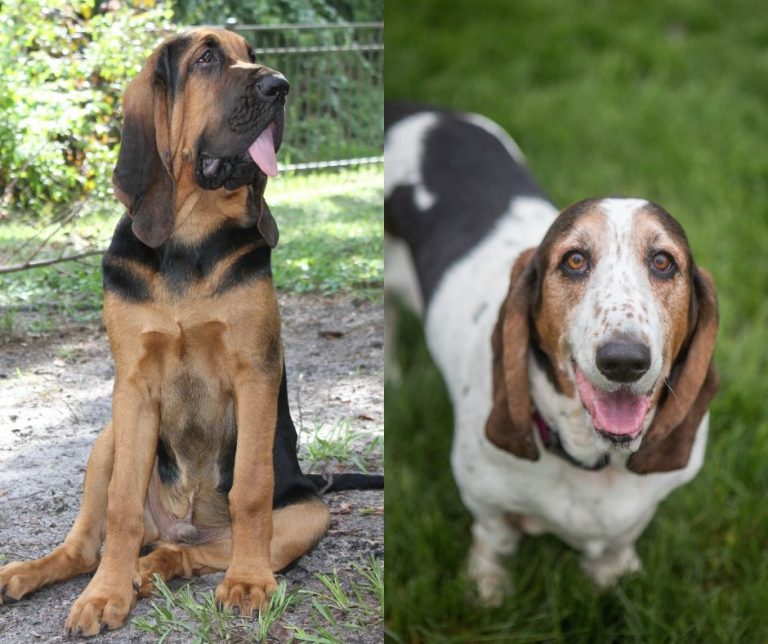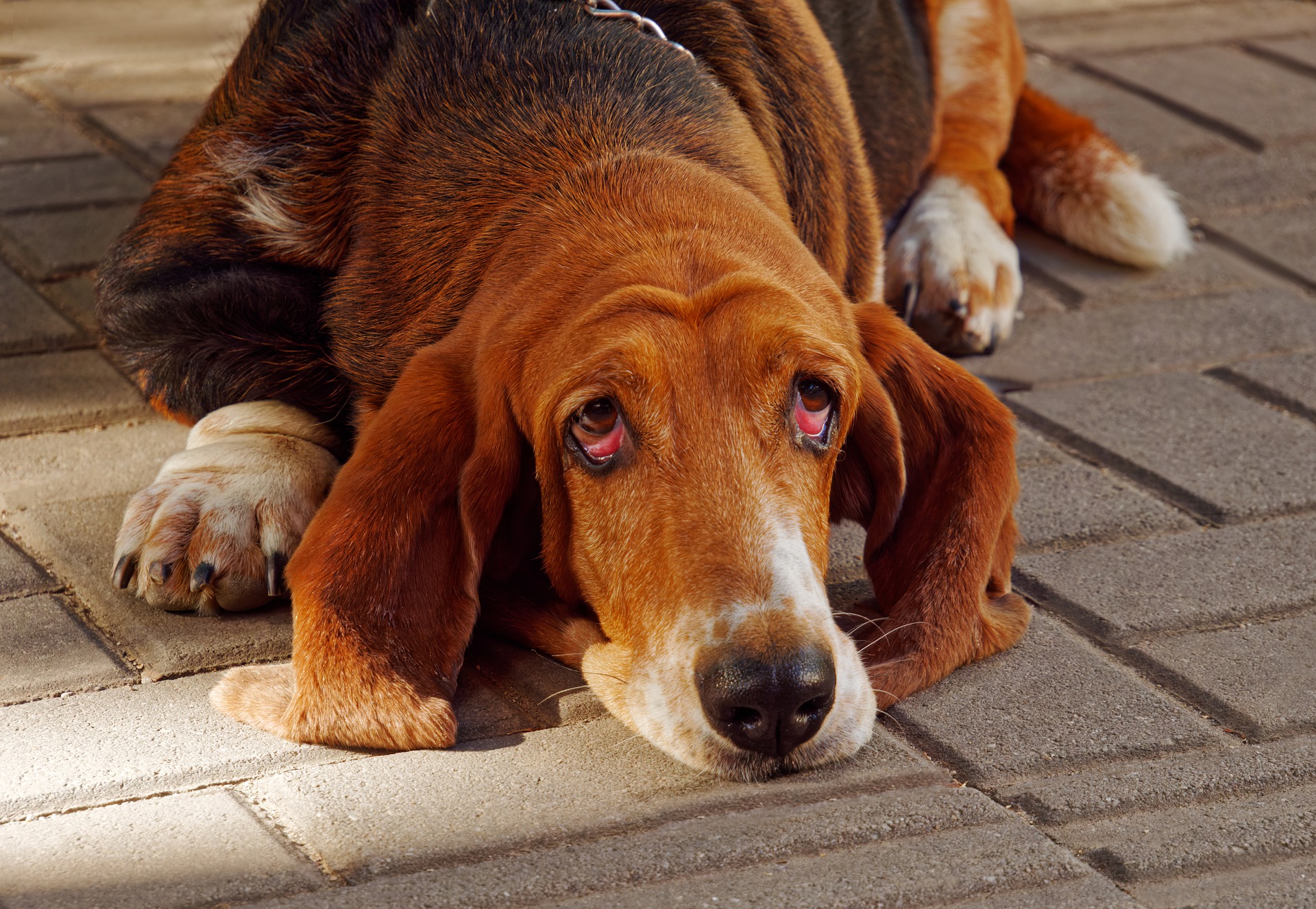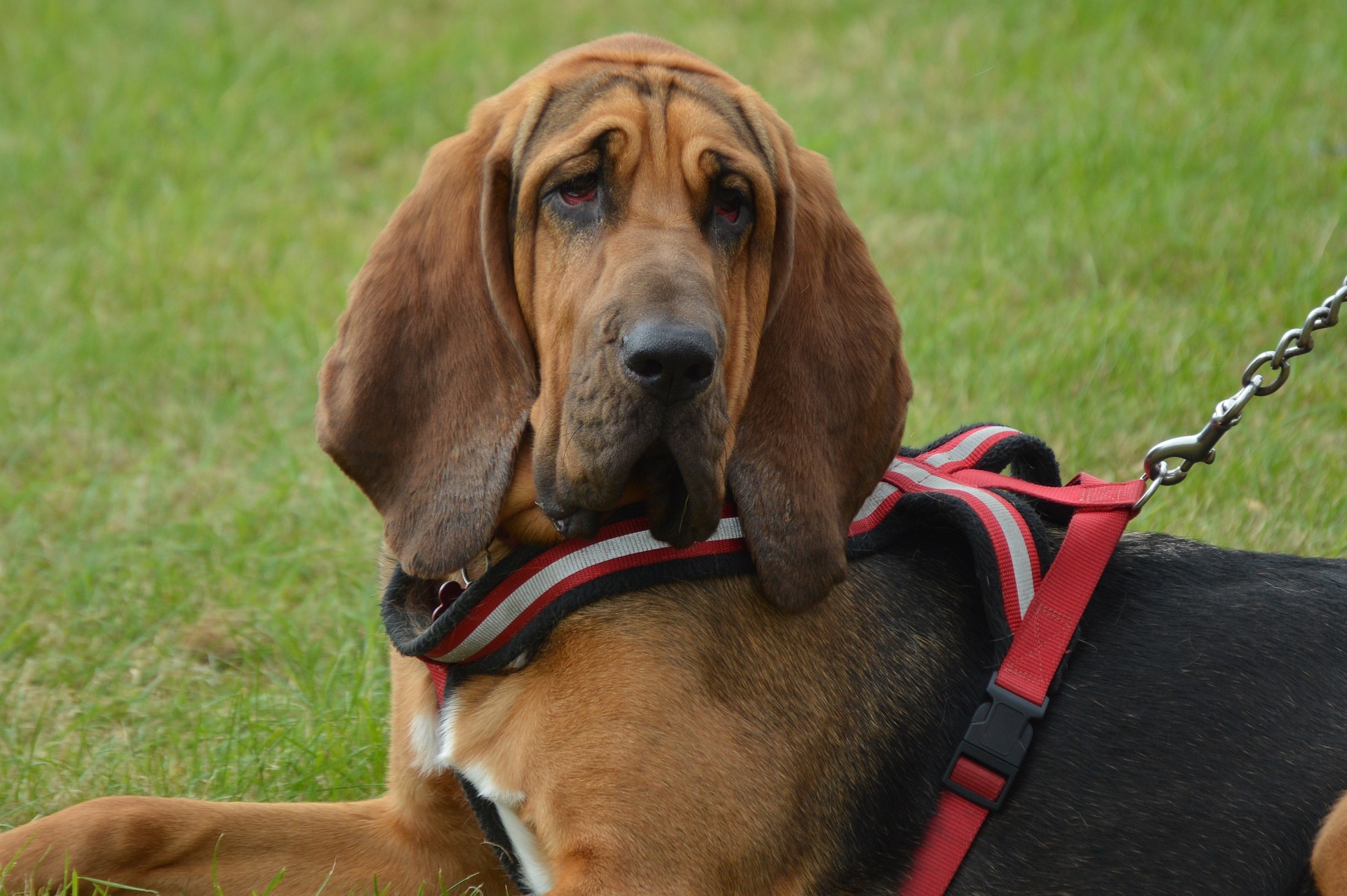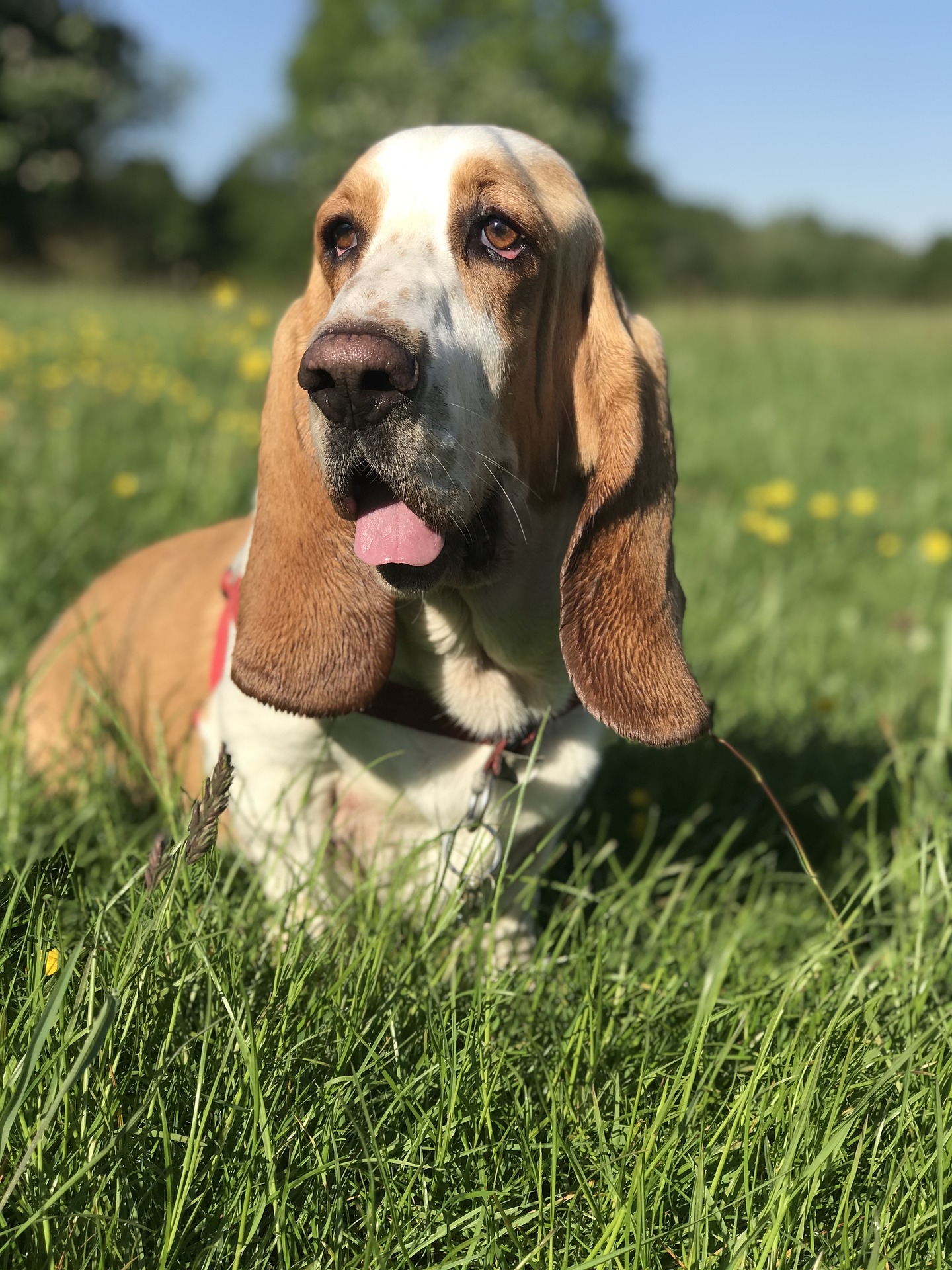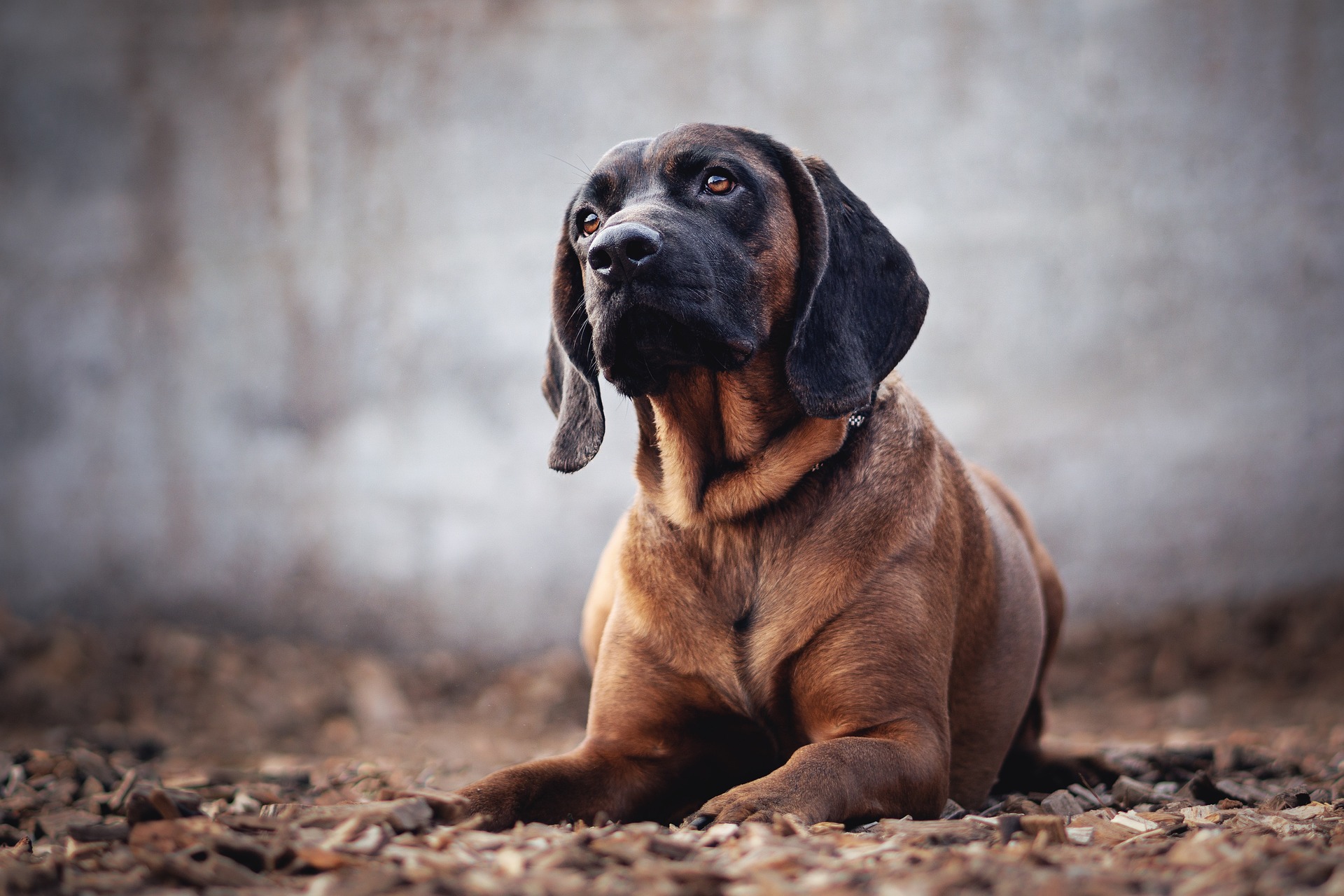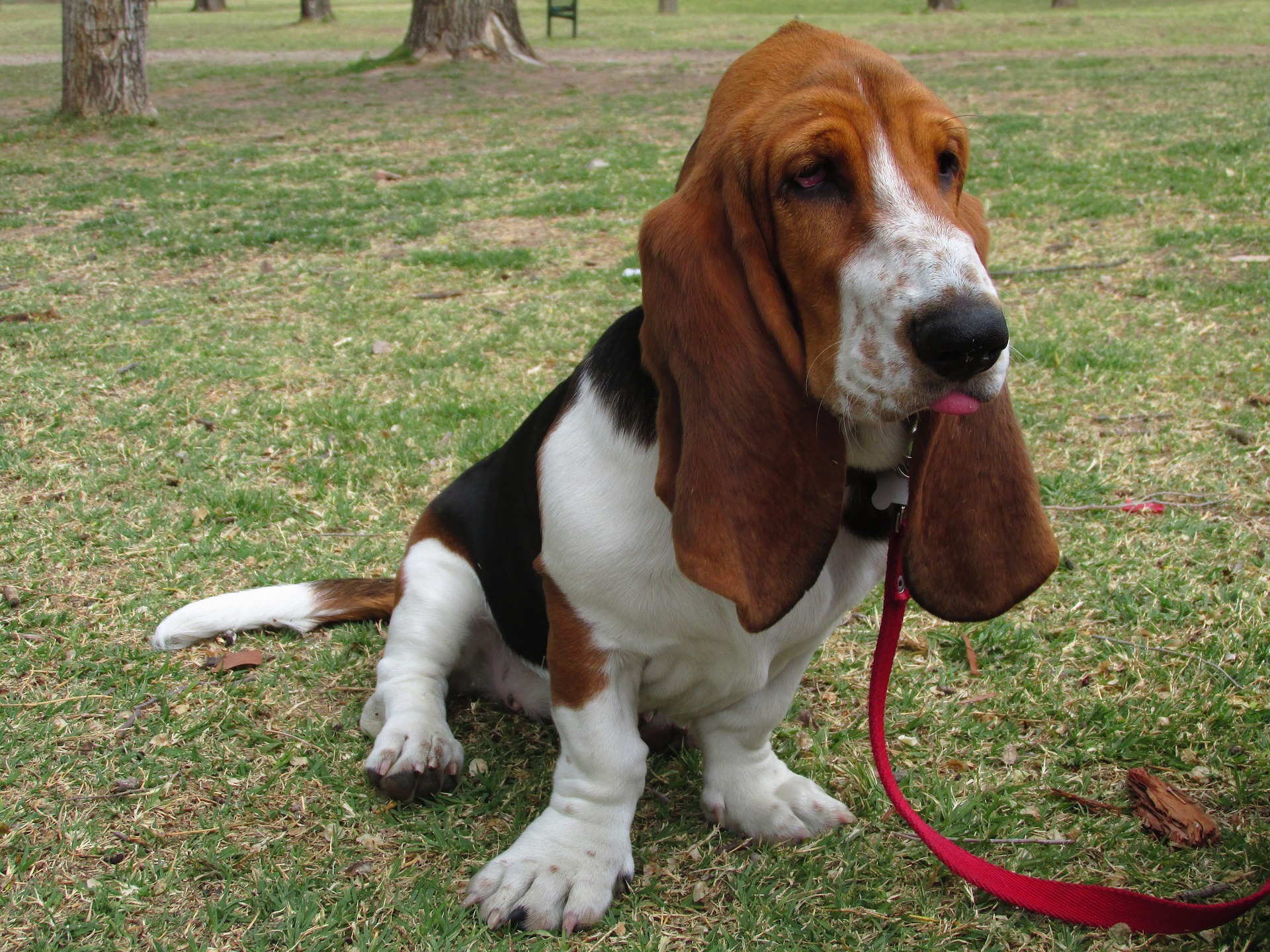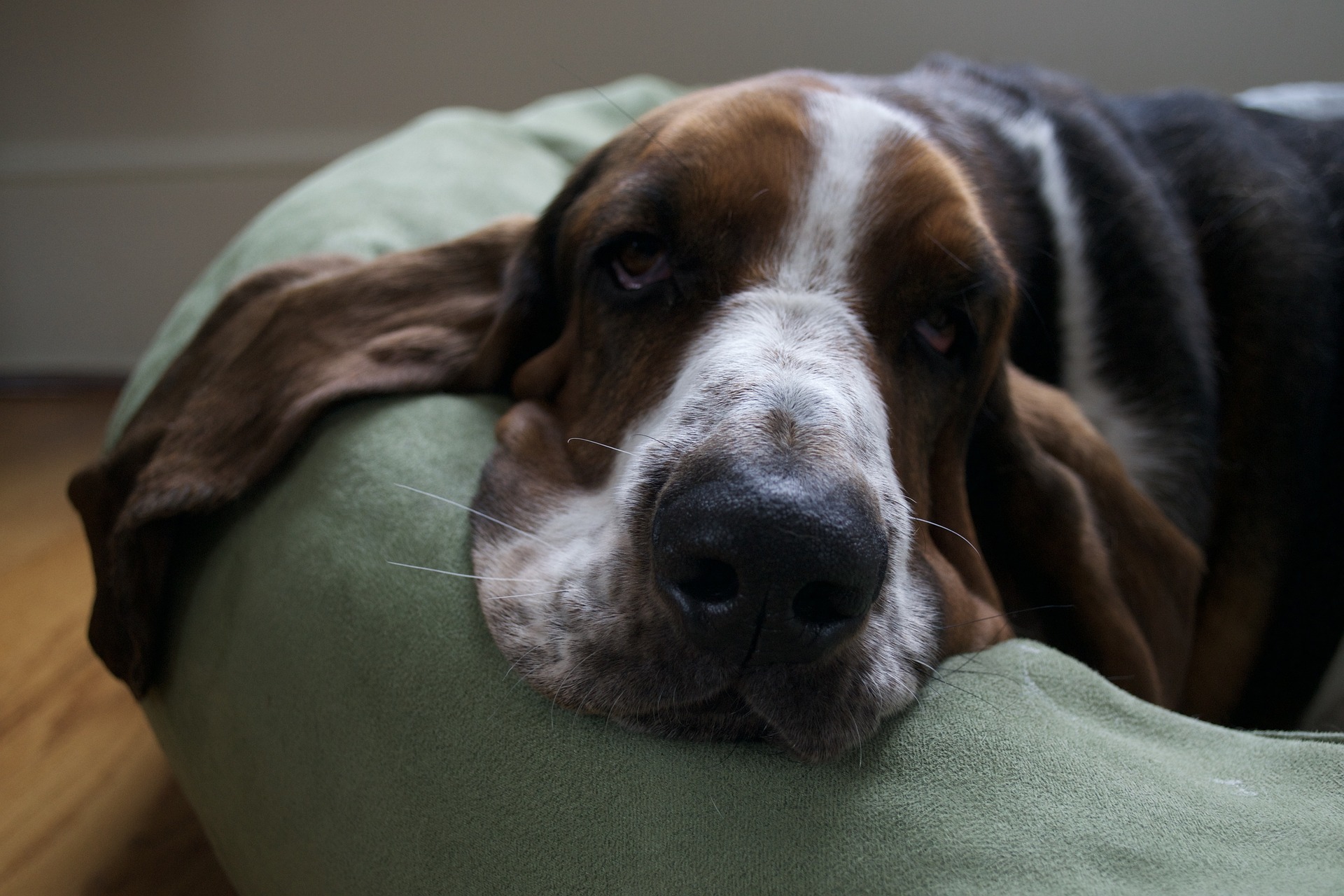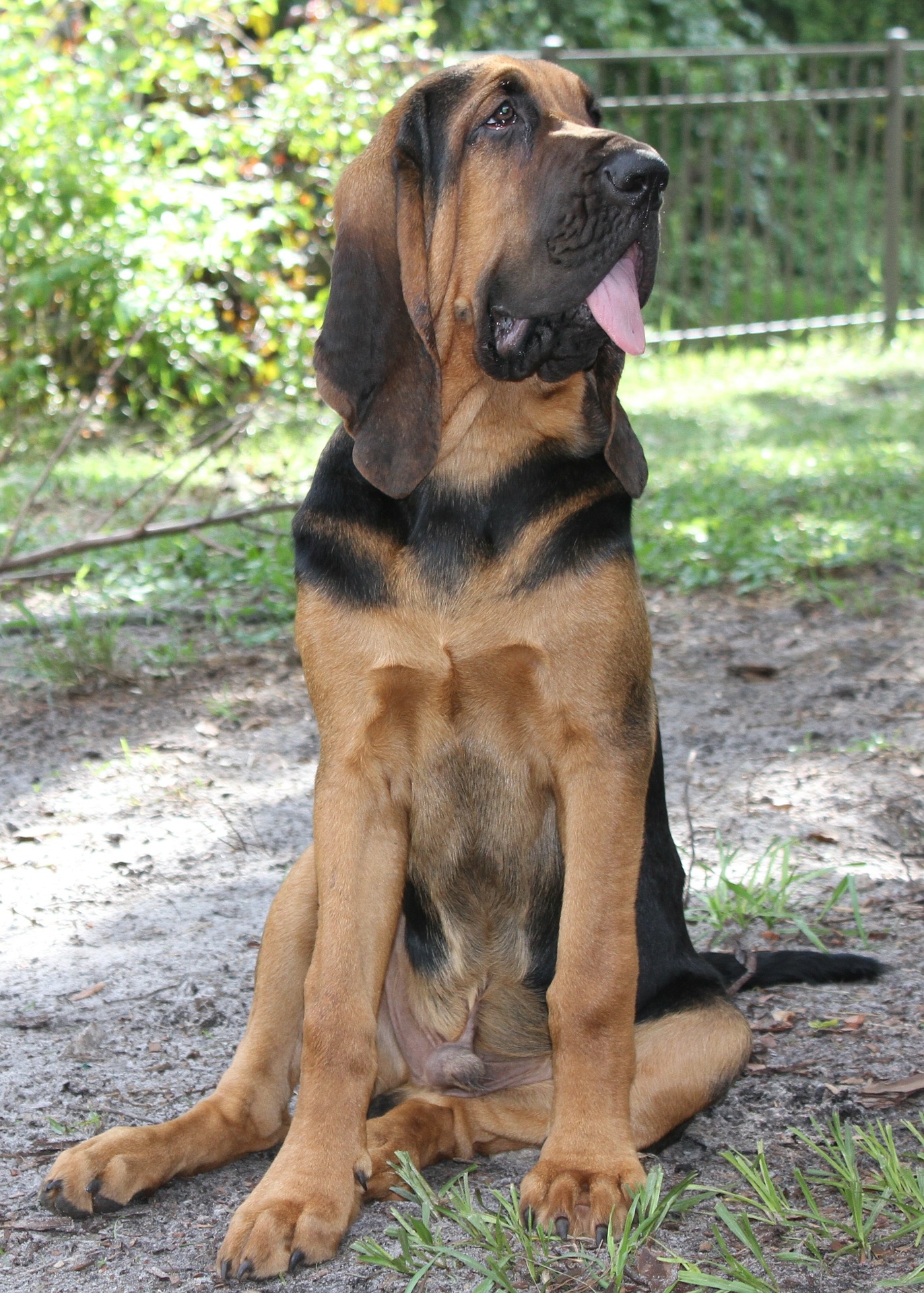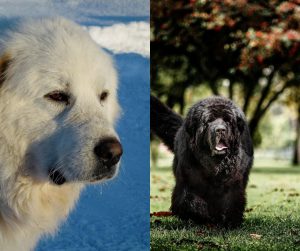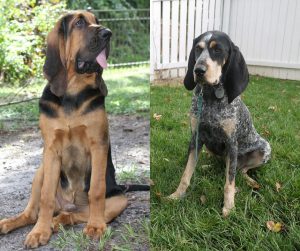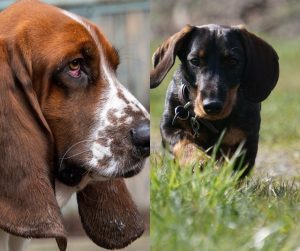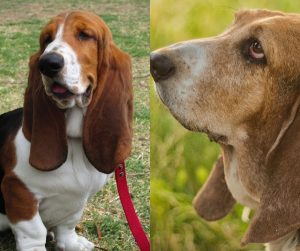When it comes to scent hounds, the Bloodhound and Basset Hound both have storied histories. Both breeds have evolved from their working dog origins to become cherished family pets.
Despite their similar scent hound designation, these two breeds have distinct differences in physical characteristics, temperament, and care needs which are important for potential owners to understand.
The Bloodhound is renowned for its tracking ability, often used for search and rescue operations and law enforcement due to its powerful nose. On the other hand, the Basset Hound, with its distinctive short legs and long ears, is a milder breed, known for being particularly good-natured and amiable, making an excellent companion for home life.
Each dog breed presents a unique set of characteristics, from the Bloodhound’s need for extensive exercise to the Basset Hound’s moderate maintenance requirements. With that in mind, let’s take a look at the Bloodhound vs Basset Hound dog breed comparison.
Key Takeaways
- Bloodhounds and Basset Hounds differ in size, energy levels, and exercise needs
- Both breeds have genial temperaments, making them suitable as family pets
- Understanding each breed’s specific care requirements is essential for prospective owners
Historical Background and Ancestry
Bloodhound and Basset Hound dogs share more than just their exceptional scent-tracking abilities; they have an intertwined ancestry that starts in Europe. Bloodhounds are one of the oldest breeds with a lineage tracing back to the St. Hubert Hounds of Belgium, and later brought to England and France. It’s said they played a game of hide and seek that goes back to medieval times.
The Basset Hound puppy has a slightly different tale. Originating in France, it’s believed they were bred in the 1800s for their short stature, which made them excellent at hunting small game such as rabbits. Their name ‘Basset’ stems from the French word for ‘low’, referencing their charmingly short legs.
Here’s a quick peek at their family tree:
- Bloodhound dog breed: Direct descendant of the St. Hubert Hounds, became well-known in Europe and later in America
- Basset Hound dog breed: Developed in Europe, specifically France, gaining popularity for its tenacity in tracking
Both are categorized as scent hound breeds, a testament to the strong olfactory abilities they inherited from their ancestors. Over time, each has developed unique characteristics, but they continue to share the bond of being diligent trackers, each with a nose that’s tough to match. Both breeds have crossed the pond and made their way to America, where they’ve found a new fan base among dog lovers who admire their keen sense of smell and endearing personalities.
They are closely related to other hounds, like the American Foxhound and Beagle. All of them are recognized by the American Kennel Club as popular hound dog breeds.
Physical Characteristics and Appearance
When choosing between a Basset Hound vs Bloodhound dog breed, size and appearance are striking factors that set these breeds apart. They both boast distinctive looks that pull on the heartstrings of dog lovers worldwide, but they’re uniquely different in stature, coat, and features.
Size Comparison
Basset Hound:
- Height: 11 to 15 inches
- Weight: Generally less than 70 pounds
Bloodhound:
- Height: 23 to 27 inches
- Weight: Can weigh up to 110 pounds
While the Basset Hound is comparably smaller with a more compact frame, the Bloodhound stands much taller. Their weight also reflects this difference, with Bloodhounds being significantly heavier than their Basset Hound cousins.
Coat and Colors
Basset Hound:
- Fur: Short, smooth
- Common Colors: Tri-color (black, white, and brown), red and white
Bloodhound:
- Fur: Short, but denser than the Basset Hound’s
- Common Colors: Black and tan, liver and tan, red
Both breeds share a short fur texture, but the Bloodhound’s coat is thicker. Color-wise, they exhibit a similar palette, but the Bloodhound’s fur can have richer, deeper shades, and its patterns vary slightly.
Distinctive Features
Basset Hounds and Bloodhounds can be immediately identified by similar features: their long ears, short legs, and droopy, expressive eyes that contribute to a somewhat ylang ylang expression. However, Bloodhounds are more wrinkled, especially around the muzzle and face, enhancing their thoughtful appearance. In contrast, Basset Hounds are less wrinkled, with a body structure that’s elongated relative to their height. To be honest, the first association people have of Basset Hound dogs is droopy ears.
Bloodhound vs Basset Hound Temperament and Personality
When choosing between a Bloodhound vs Basset Hound, understanding their distinct temperaments and personalities is crucial. These breeds show a mix of stubbornness and affection, shaping their interactions with families and other pets.
Bloodhound’s Behavior
Bloodhounds are celebrated for their exceptional tracking abilities, showcasing a behavior that is both patient and determined. A Bloodhound’s temperament is generally friendly and gentle, making them excellent companions. They are known to be kind-hearted and good with families, often forming strong bonds with their owners which highlights their loyal nature. However, their tenacity on the trail can also reflect at home, as Bloodhounds can exhibit moments of stubbornness.
Basset Hound’s Nature
In contrast, Basset Hounds possess a very easy-going and laid-back personality. They are extremely affectionate and enjoy the company of their human and animal family. While they have a tendency to be stubborn at times, Basset Hounds approach life with a calm demeanor. Often characterized by their friendliness, they are typically patient with children and other pets. This breed’s affectionate nature makes them a beloved pet for many households.
Health and Maintenance
When considering a Bloodhound or Basset Hound as a pet, understanding their health and maintenance needs is crucial for a happy and healthy life. These loveable breeds come with their own unique set of requirements, so let’s get into the details.
Common Health Issues
Both Bloodhounds and Basset Hounds share susceptibility to certain health issues, such as hip dysplasia and elbow dysplasia, which affect their joints and can cause discomfort. It’s also common for them to experience ear infections due to their long, floppy ears. A responsible owner should watch for signs of these conditions and consult a veterinarian for regular check-ups to manage them effectively.
Grooming Needs
When it comes to grooming, these dogs have different needs. Bloodhounds have a short coat that requires regular brushing to minimize shedding. On the flip side, Basset Hounds have a similar coat but may require more frequent cleaning of their ears to prevent infections. Both breeds benefit from a consistent grooming routine to keep them looking and feeling their best.
Exercise Requirements
Bloodhounds, being high-energy dogs, need plenty of exercise to keep them fit and to help manage their energy levels. They delight in long walks and tracking activities that stimulate both their body and mind.
On the other hand, Basset Hounds, while not as high-strung, still require regular exercise to maintain health, though they often have a more laid-back approach to physical activity. For both breeds, daily exercise is an integral part of their maintenance and overall well-being.
Bloodhound vs Basset Hound Training and Intelligence
When it comes to the Basset Hound and the Bloodhound, their intelligence shines through in their remarkable scent capabilities. However, their trainability differs, calling for patience and understanding from their trainers.
Trainability
Basset Hounds are intelligent dogs with a specific talent for scent work. They rank 71 out of 130 dog breeds in terms of intelligence, demonstrating that they have the capacity to learn, but they require a consistent and patient trainer. Due to their independent nature, they might not be the easiest to train and can be quite stubborn. They need to be trained with a confident hand and have been known to require 80 to 100 repetitions to learn new commands effectively.
Bloodhounds, on the other hand, score closely at 74 out of 130 for intelligence. They too are not naturally inclined to please people, which can make their dog training challenging. Like Basset Hounds, Bloodhounds excel at tracking scents. Their trainability is affected when they catch a scent, as this can distract them significantly and they may need extra encouragement to stay on task.
Tips for Effective Training
To make dog training sessions more effective, owners should:
- Use positive reinforcement: Both breeds respond well to treats and praise
- Be consistent: Consistency is key in helping these dogs understand what is expected of them
- Understand their nature: If a Bloodhound catches a scent or a Basset Hound becomes stubborn, it’s crucial to remain patient and not punish their natural inclinations
- Start training early: It helps them adapt to following commands and reduces their sleuthing tendencies during training sessions
Living with a Hound
When considering bringing a hound into your home, it’s essential to understand that these companions will shape your living space and routine with their specific needs, from their exercise requirements to their sociable natures.
Home Environment
Hounds, like the Bloodhound and Basset Hound, thrive in a supportive home environment that accommodates their energy levels and need for companionship.
They typically do well in families due to their affectionate nature, but their size and energy may vary.
For instance, Bloodhound dogs require more space and exercise due to their larger size and higher energy levels, making them better suited for houses with yards rather than small apartments.
In contrast, Basset Hound dogs can adapt to smaller spaces thanks to their more manageable size and moderate energy levels, though they still appreciate a good romp outdoors.
Regardless of breed, both can experience separation anxiety; they are pack animals at heart and may need another pet or human presence to feel at ease.
It’s important to create an environment with comfort spaces where your hounds can relax and feel secure.
Also consider that hounds are known for drooling; some dog-friendly throw blankets could save your furniture and provide them a designated spot to unwind.
With Children and Other Pets
Both Bloodhounds and Basset Hounds are known for their good-natured demeanor and can be excellent family pets.
They generally show a gentle and patient character, making them suitable companions for children.
Always supervise interactions with younger kids, as these dogs can be large and inadvertently knock over a small child with their enthusiasm.
When it comes to other pets, these hounds are often quite sociable.
The key to a harmonious household is proper introduction and training.
For example, a Basset Hound puppy is more likely to be laid-back when meeting new furry siblings—many owners find they blend into families with existing pets well.
Bloodhounds, with their tracking instincts, may require more careful management around small animals but often coexist peacefully with other dogs.
Adoption and Breeders
When considering the addition of a Basset Hound or Bloodhound to the family, one stands before two paths: adoption or connecting with a reputable breeder. Each route has its own set of considerations, from the dogs’ pasts to health conditions and everything in-between.
Choosing to Adopt
Adopting a dog is a noble and rewarding decision. It’s not just giving a home to a dog in need, but often a second chance at life.
Whether it’s in America or Europe, there are numerous rescue organizations dedicated to these breeds. Families might find older dogs through adoption, which can come with the advantage of skipping the demanding puppy stage.
When adopting, it’s important to inquire about the dog’s history and any known health conditions, which tend to be more prevalent in purebreds like the Basset Hound and Bloodhound.
How to select a Breeder
If a family decides on a Bloodhound or Basset Hound puppy, sourcing from a reputable breeder is crucial.
It’s essential to look for breeders who prioritize the health and well-being of their dogs.
In countries like Belgium and France, where the Basset Hound has historic roots, breeders should provide proof of genetic testing and clearances.
Prospective owners should expect to engage in detailed discussions with breeders to understand the upbringing and lineage of their potential new puppy.
Preparing for a Puppy
Welcoming a puppy into the home requires preparation. A responsible breeder can provide a wealth of knowledge on this.
They can guide new owners through the necessary steps to welcome their Bloodhound or Basset Hound, covering everything from diet to managing genetic health conditions that may arise.
It’s essential to ensure the living environment is safe and suitable so that the puppy and family can enjoy a smooth integration.
Breed Comparison and Popularity
When comparing the Bloodhound and Basset Hound, it’s clear they belong to the scent hound group, renowned for their tracking abilities.
However, the Bloodhound stands taller and heavier. Males reach 23 to 27 inches tall, while the Basset Hound typically measures 11 to 15 inches in height. The size difference plays a part in their respective popularity.
Larger Bloodhounds are sought after for their impressive tracking skills. Meanwhile, smaller Basset Hounds are adored as family pets.
| Feature | Bloodhound | Basset Hound |
|---|---|---|
| Popularity | Rising due to tracking skills | Stable, often in media |
| Size | 23-27 inches tall | 11-15 inches tall |
| Role | Trackers, Hunters | Family pets |
| Lifespan | 10-12 years average | 10-12 years average |
| Prey Drive | High | Lower than Bloodhounds |
Bloodhounds have a gentle temperament and a notable prey drive, which serves them well as hunters and trackers. They’re becoming more recognized for their capabilities in these areas.
On the other hand, Basset Hounds, with their laid-back personality, have historically charmed their way into the hearts of many through media portrayals.
These short but sturdy dogs share a similar lifespan with their larger counterparts, averaging around 10-12 years.
In terms of popularity, trends show a growing appreciation for Bloodhounds’ abilities while Basset Hounds maintain consistent admiration for their temperament and manageability as hound dogs suitable for family life.
Both breeds have unique qualities that contribute to their popularity.
While the Bloodhound excels in following a scent trail to track, the Basset Hound, though still a capable tracker, tends to be a more accessible pet for families due to its size and character.

